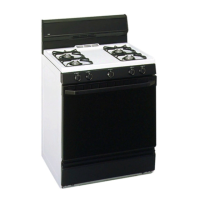❑ mmm THE OVENBURHEROR9F9CES
oven Bu8’ner
1. Remove oven door, storage drawer or broiler
drawer and oven bottom..The lower burner
orifice spud is located behind the storage drawer,
broiler drawer or kick panel. (On some models, a
metal shield must be removed to access the
orifice.)
2. To convert ti LP gas,
use a 1/2” wrench to
turn the
lower burner
orifice spud cloclmise.
Tighten the spud only
until it is snug. To
prevent damage, do not overtighten the spud.
To
convertto naturalgas, loosen the spud
about 2 turns.
E
CMVERTAIRADJUSTMEHT SHUTTER
For LP gas, loosen the
screw
~PS
head screw and
rotate the shutter to the full
Air Shutter
open position.W~thbaffle in
place, flames should have
approximately l-inch blue
cones and should not extend beyond the edges of
the burner bathe. After 30 seconds of burner
operation, check for flames lifting offburner ports.
Iflifting is observed, gradually reduce air shutter
opening until flames are stabilized.
For natural gas, the shutter should be open
1/2” or about 3/4 ofthe way open.
❑ CHECKFOR LEAKS
When all comections have been made, make sure
all range controls are in the offposition and turn
on the main gas supply valve. Use a liquid leak
detector at alljoints and connections to check for
leaks in the system.
CAUTION: DO NOT USE A I?MME ‘IT)
CHECK FOR GAS IJMKS.
When using test pressures greater than 1/2 psig
to pressure test the gas supply system ofthe
residence, discomect the range and individualshut-
offvalvefromthe gas supplypiping.When using test
pressures of 1/2 psig or less to test the gas supply
system, simplyisolatethe range fromthe gas supply
system by closing the individualshut~ff valve.
2. Remove all four knobs.
3. With a small flat blade
screwdriver, turn the
valve set screws
clockwise to decrease
%
<*
flame size,
counterclockwise to
increase flame size.
Adjust until the flame
is about the same height as the top of the burner.
4. Replace the knobs.
5. Check for flame outage by opening and
closing the oven door several times. If the flame
goes out increase the flame size.
❑ CHECKQUALITY OF FLAMES
The combustion qwdity of burner flames needs
to be determined visually
A Yellow flatnes-
&)
all for service
1
(B) Yellow tips on outer
cones-Normal for LP gas
(C) Soft blue fiames-
Normal
for natural gas
Ifbumer flames look like (A),call for service.
Normal burner flames should look like (B)or
(C), depending on the type of gas you use.
~n~m~das, some yellow tipping on outer cones
.
)“
k’
The conversion for sealed burner models is
now complete.
I
40
—...——-
..—

